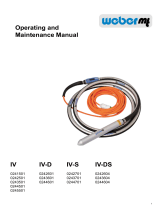
Inhaltsverzeichnis
5100013660IVZ.fm 3
1 Preface ....................................................................................................................................5
2 Introduction ............................................................................................................................6
2.1 Using the manual......................................................................................................................... 6
2.2 Storage location of the manual.................................................................................................... 6
2.3 Accident prevention regulations................................................................................................... 6
2.4 More information.......................................................................................................................... 6
2.5 Target group................................................................................................................................ 6
2.6 Explanation of symbols................................................................................................................ 6
2.7 Wacker Neuson Contact partner ................................................................................................. 7
2.8 Disclaimer.................................................................................................................................... 7
2.9 Product identification of the machine........................................................................................... 7
3 Security ..................................................................................................................................8
3.1 Policy........................................................................................................................................... 8
3.2 Qualification of the operating personnel.................................................................................... 10
3.3 Protection equipment................................................................................................................. 10
3.4 Transport ................................................................................................................................... 11
3.5 Operating safety ........................................................................................................................ 11
3.6 Safety when operating hand-held equipment............................................................................ 12
3.7 Safety when operating electrical equipment.............................................................................. 13
3.8 Safety when operating modular internal vibrators ..................................................................... 14
3.9 Maintenance.............................................................................................................................. 14
4 General safety instructions for power tools .....................................................................15
5 Safety and information labels ............................................................................................17
6 Setup and function ..............................................................................................................18
6.1 Standard package ..................................................................................................................... 18
6.2 Application................................................................................................................................. 18
6.3 Application area......................................................................................................................... 18
6.4 Mode of operation...................................................................................................................... 18
7 Components and operator's controls ................................................................................19
7.1 Components and operator's controls of the drive motor............................................................ 19
7.2 Components of the HMS ........................................................................................................... 19
7.3 Components of the flexible shaft (optional) ............................................................................... 20
7.4 Components of the vibrator head (optional) .............................................................................. 20
8 Transport, entire system (HMS) .........................................................................................21
9 Assembly of the HMS ..........................................................................................................22
9.1 Pre-assemble the vibrator head................................................................................................. 22
10 Operation ..............................................................................................................................24
10.1 Before commissioning ............................................................................................................... 24
10.2 Commission............................................................................................................................... 24
10.3 Decommissioning ...................................................................................................................... 26
11 Maintenance .........................................................................................................................27
11.1 Qualification of the maintenance personnel............................................................................... 27
11.2 Maintenance schedule............................................................................................................... 27
11.3 Maintenance work...................................................................................................................... 28
12 Troubleshooting ..................................................................................................................33
13 Permissible combinations ..................................................................................................34
13.1 Drive motor – Flexible shaft – Vibrator head ............................................................................. 34
























